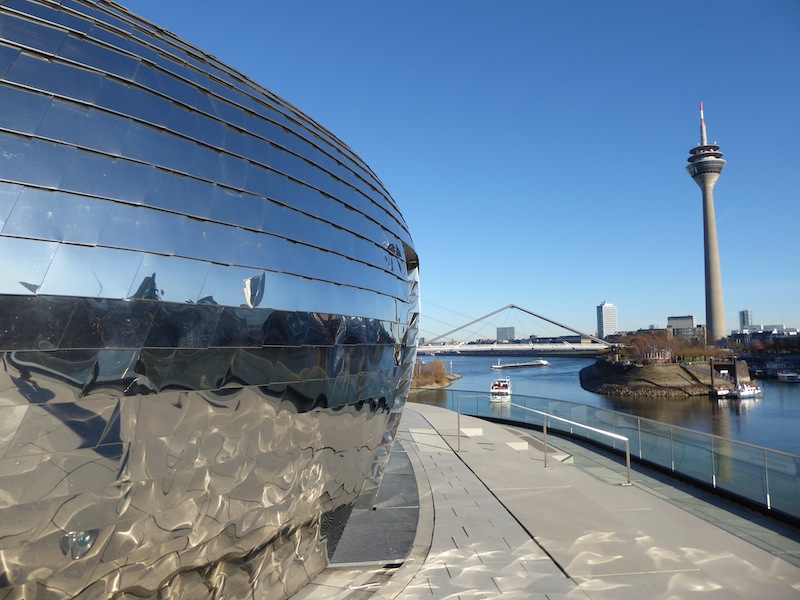Contemporary architecture has given a new lease of life to Dusseldorf’s old harbour.
The district known as MedienHafen features striking buildings by such world famous architects as Frank Gehry, David Chipperfield, Joe Coenen, Steven Holl and Claude Vasconi. On a day blessed with beautiful blue skies, it would be the conclusion to our walk through the city and our weekend break.
We began in the Hofgarten, the park next to our hotel, and walked to Dusseldorf’s premier shopping street and Instagram favourite, the Konigsallee. This grand kilometre-long road has its own canal lined with trees, punctuated by the over-the-top Triton Fountain. Being a Sunday, the shops were closed and a street that would otherwise be busy with bustling shoppers was noticeably quiet. Being winter, the fountain had been turned off.

We explored neighbouring back streets and some of the oldest parts of the city, which offered up serene squares, proud churches and handsome homes, emerging near the Rheinkniebrucke – one of the principal bridges in the city. Down on the riverbank locals were out in force, promenading in the sunshine beside rows of ruthlessly pollarded trees, while huge barges glided by on the Rhine carrying a wide range of consumer goods and industrial bits and pieces. Back towards the Altstadt, a big wheel dominated the skyline alongside the twisted spire of St Lambertus Church.
We walked past the giant telecommunications tower, the Rheinturm, into MedienHafen and stopped to admire Frank Gehry’s Dusseldorf work. This curious collection of three buildings twist, slope and swirl along the waterside, each with a different finish – one in white, one in red brick and one in reflective metal that shimmered spectacularly in the sunshine.

It’s certainly a stand-out building, reminiscent of Gehry’s work in the Czech capital of Prague, usually known as the Dancing Building or Fred and Ginger. Elsewhere in the harbour were a series of other modern buildings, each one notable but some rather more startling than others. Some of the older harbour buildings had been preserved and given a new lease of life amid the modernity. A nice addition opposite Gehry’s work was a pebble-shaped cafe that had also been dressed in reflective metal sheets.
One of the least impressive buildings had been given a makeover courtesy of sculptor Rosalie. A number of colourful figures, called Flossis, had been stuck to the outside, the roof and one or two neighbouring buildings. With their giant hands and feet, they scaled the walls looking weird but wonderful.

We walked around snapping photos but the area was surprisingly quiet. Most of the cafes and fine-dining restaurants for which the modern harbour is known were closed. Unlike London’s Canary Wharf district, little effort has been made to give the area a function at the weekend. Still, we found a restaurant that was open and stopped for food – in my case a particularly firey sausage pasta affair. I managed a beer or two despite an earlier hangover.
On the way back we stopped at the Rheinturm, where the queues for a ride up to the top were a lot shorter than earlier in the day. The building, a concrete telecommunications tower that stands 240.5 metres high, was completed in 1982. On its outside it has a digital clock but it didn’t look much to me, at least at close range.

The Rheinturm is not as impressive a feat as the CN Tower in Toronto or its equivalent in Berlin but is still the most obvious feature of Dusseldorf’s skyline. We rode up in the lift to the viewing platform at about 170 metres and joined the crowds admiring the cityscape, which wasn’t easy because of the number of cafe tables and chairs lined up by the windows.
The Rhine was the most obvious feature of the largely flat landscape, slicing its way north and south, glinting in the sunlight and spanned by several modern bridges. Out in the far distance, giant power stations in Germany’s industrial belt billowed steam into the frosty December air. Down below us stood the modern circular buildings of the Landtag, the North Rhine-Westphalian parliament.
With our time in the city running out, we walked back through the Altstadt that we’d come to know so well during our stay, stopping again at the Marktplatz Christmas Market for one last warming gluhwein amid the Sunday afternoon strollers.
And with that our visit was over. It was time to take a taxi to the airport.
Dusseldorf is not a city with the wealth of attractions that would tempt us back a second time, but for a few days soaking up the festive atmosphere it had delivered…

